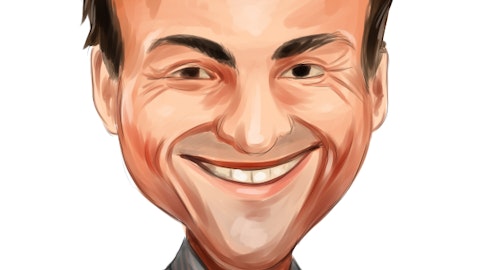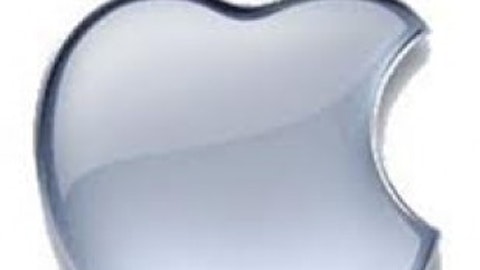Hedge fund managers meet at the annual Sohn Conference, where they pitch their favorite ideas to raise money for pediatric cancer.
This year, Bill Ackman brought forth a simple idea, one which won’t draw him criticism like his Herbalife short last December.
Ackman says Procter & Gamble is a top pick

Bill Ackman’s firm, Pershing Square Capital, believes a combination of cost-cutting and foreign growth can lead to returns of more than 60% for investors who buy at the current price. One slide from his research shows The Procter & Gamble Company (NYSE:PG) has huge exposure to emerging markets:
At the mid-point, Ackman says The Procter & Gamble Company (NYSE:PG) can set the pace for 5% annual revenue growth. That kind of top-line expansion doesn’t seem to be priced into the company’s stock, given that it trades with a dividend yield of 3%. Slap on 5% growth in revenue in perpetuity, and consistent margins, and you have an 8% return per year already using a simple dividend discount model.
Foreign growth is often forgotten
Emerging markets can go ignored for a very long time, even in the largest of businesses. When Warren Buffett famously put more than a billion dollars in The Coca-Cola Company (NYSE:KO) in the 1980s, he drew criticism for buying one of the companies least likely to grow.
Except Buffett saw what no other investors did: soda consumption was rising per capita, and the number of people drinking soda was exploding, too. Combine more users with more consumption per user and you get a long-term, dividend-paying multi-bagger of a stock. Warren Buffett clearly won on that trade, and Berkshire Hathaway Inc. (NYSE:BRK.A) remains one of The Coca-Cola Company (NYSE:KO)’s biggest shareholders.
Ackman is onto the same idea for The Procter & Gamble Company (NYSE:PG). Ackman’s multiplier is in emerging market growth, and a huge billion-dollar cost-cutting program for The Procter and Gamble Company (NYSE:PG) that would leverage the company’s growing international sales.
Pershing Square sees the gross margin improving by just under 2% with SG&A expenses shrinking by 2016 to 27.5% of revenue. Should the cost savings develop atop slight margin expansion, Ackman puts P&G’s EBIT margin at 24% from 18.8%, adding roughly a third to profitability.
Given 5% annual revenue growth, The Procter & Gamble Company (NYSE:PG) would earn $6 per share by 2016, and an earnings multiple of 20 makes P&G a $120 stock by 2016.
Banking on small downside
Sometimes the market gives investors asymmetric risk profiles, where upside is better than the downside. If you find enough of these trades, winners balance out losers, and you get market beating performance.
What makes Ackman’s view on P&G most interesting is its valuation relative to comparable companies:

Procter & Gamble trades at a lower valuation than rivals despite the fact that it has both the potential for large cost savings by 2016 and opportunities to grow at high single-digits in emerging markets around the globe.
Put simply, investors are pricing P&G as if it will fail to realize a dime in cost savings or above-average growth in the top line. That doesn’t seem so likely. Ackman’s thesis working perfectly doesn’t seem so likely, either. Cost-cutting hasn’t gone entirely to plan, and a shrinking investment in marketing and branding may come at the cost of lost sales or market share.
However, for a massive, well-positioned consumer product company to trade at a discount to peers like Church & Co., Inc. (NYSE:CHD) and The Clorox Co (NYSE:CLX), Procter & Gamble looks like a relative value. The Clorox Co (NYSE:CLX) has very little meaningful costs it can squeeze into profits after a highly-effective cost cutting program in 2003. Church & Co., Inc. (NYSE:CHD) ramped its operating margins by nearly 5% on lower costs over the past five years.
Church & Dwight is perhaps the best comparable for P&G. Like Procter, its portfolio includes several number one brands in their categories. Its top brands include Arm & Hammer, Orajel, Oxiclean, Nair, Spin Brush, Xtra, First Response, and Trojan – all of which have a number one position in their category and are included in the 8 top brands at Church & Dwight. Clorox brands are positioned primarily in household cleaners. The company’s namesake bleach has a 50% share, while brands like Pine Sol, 409, and SOS further lock down the company’s position in the space.
Neither Church & Dwight or Clorox offer more margin expansion without higher prices – higher prices that would lead P&G to use its own inherent pricing power. That leaves Procter & Gamble as the only true home, health, and beauty player with upside in its own unique margin expansion as it rapidly slashes costs.
As such, Procter & Gamble makes for the only play in the space with the potential to drive profits solidly higher by trimming the fat. The market isn’t pricing it at a premium, meaning any cost savings is pure upside.
The article Ackman’s New Favorite Large Cap Stock originally appeared on Fool.com and is written by Jordan Wathen.
Copyright © 1995 – 2013 The Motley Fool, LLC. All rights reserved. The Motley Fool has a disclosure policy.


